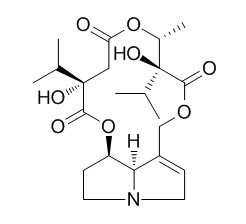Parsonsine
Reference standards.
Inquire / Order:
manager@chemfaces.com
Technical Inquiries:
service@chemfaces.com
Tel:
+86-27-84237783
Fax:
+86-27-84254680
Address:
1 Building, No. 83, CheCheng Rd., Wuhan Economic and Technological Development Zone, Wuhan, Hubei 430056, PRC
Providing storage is as stated on the product vial and the vial is kept tightly sealed, the product can be stored for up to
24 months(2-8C).
Wherever possible, you should prepare and use solutions on the same day. However, if you need to make up stock solutions in advance, we recommend that you store the solution as aliquots in tightly sealed vials at -20C. Generally, these will be useable for up to two weeks. Before use, and prior to opening the vial we recommend that you allow your product to equilibrate to room temperature for at least 1 hour.
Need more advice on solubility, usage and handling? Please email to: service@chemfaces.com
The packaging of the product may have turned upside down during transportation, resulting in the natural compounds adhering to the neck or cap of the vial. take the vial out of its packaging and gently shake to let the compounds fall to the bottom of the vial. for liquid products, centrifuge at 200-500 RPM to gather the liquid at the bottom of the vial. try to avoid loss or contamination during handling.
Environ Toxicol.2020, doi: 10.1002
Nat Commun.2021, 12(1):681.
J Med Assoc Thai2024, P-04.
J Ethnopharmacol.2017, 196:75-83
Environ Toxicol.2023, 38(7):1641-1650.
Phytother Res.2020, 34(4):788-795.
ACS Omega2020, 5,33,20825-20830
Evid Based Complement Alternat Med.2018, 2018:3610494
Manomaniam Sundaranar University2023, 3859769.
JLiquid Chromatography & Related Tech.2021, 10826076.
Related and Featured Products
Insect Biochem Mol Biol. 2003 May;33(5):515-23.
Biochemical processing of plant acquired pyrrolizidine alkaloids by the neotropical leaf-beetle Platyphora boucardi.[Pubmed:
12706631]
Leaf beetles of the genus Platyphora, feeding on plant species containing pyrrolizidine alkaloids of the lycopsamine type, not only sequester these alkaloids and concentrate them in their exocrine defensive secretions, but also specifically process the plant acquired alkaloids.
METHODS AND RESULTS:
Using P. boucardi as subject, three mechanisms were studied: (i). utilization of host plant alkaloids that are not sequestered per se; (ii). elucidation of the mechanism of the already documented C-7 epimerization of heliotridine O(9)-monoesters; (iii). the specificity of insect catalyzed necine base esterification. P. boucardi does not sequester the triester Parsonsine, the principal alkaloid of its host plant Prestonia portobellensis (Apocynaceae). Beetles fed with a purified mixture of nor-derivatives of Parsonsine, obtained from Parsonsia laevigata, did not sequester the triesters but transformed them by partial degradation into monoesters that are accumulated in the defensive secretions. The mechanism of the previously described transformation of rinderine into intermedine by C-7 epimerization was elucidated by feeding C-7 deuterated heliotrine (3'-methylrinderine).
The transformation of heliotrine into epiheliotrine (3'-methylintermedine) catalyzed by P. boucardi is accompanied by complete loss of deuterium, indicating the same mechanism of an oxidation-reduction process via a ketone intermediate as recently demonstrated in a pyrrolizidine alkaloid sequestering lepidopteran.
CONCLUSIONS:
P. boucardi is able to form ester alkaloids from five different necine bases fed as radioactively labeled substrates. However, besides C-7 epimerization the beetles are not able to convert simple necine bases into retronecine. The functional importance of the various alkaloid transformations is discussed in comparison to striking parallels of analogous reactions known from pyrrolizidine alkaloid sequestering Lepidoptera.



